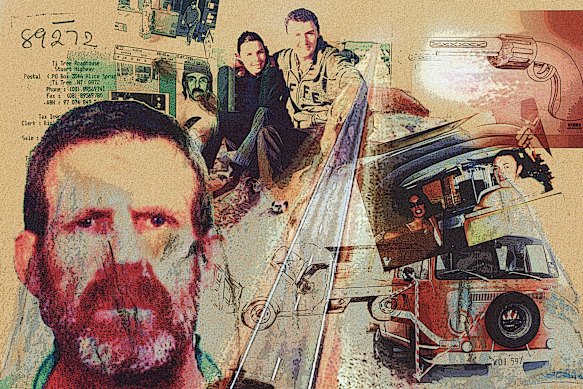Opinion
Still people ask me: Did Murdoch really kill Falconio? I have only one response
Sue Williams
Contributing writerIn his prison cell, Bradley John Murdoch read the book I wrote about him – that and the other five detailing his crimes. Further feeding his ego were the blanket media coverage and five documentaries. Then there were the Wolf Creek and Wolf Creek 2 horror films, and the TV spin-off – also called Wolf Creek – all loosely based on a mix of two backpacker killers, Murdoch and Ivan Milat.
Murdoch, a bastard until the end, refused until his death on Tuesday night in a hospital palliative care unit in Alice Springs – his only respite from jail – to reveal where he’d hidden the body of British tourist Peter Falconio. Monday had marked 24 years to the day that Murdoch shot dead Falconio and attempted to abduct his girlfriend, Joanne Lees, near the remote Northern Territory town of Barrow Creek, on the lonely road from Adelaide to Darwin.

Bradley John Murdoch was convicted of the murder of British backpacker Peter Falconio and the attempted abduction of Joanne Lees in the Northern Territory.Credit: Harry Afentoglou
Murdoch had hoped that continually protesting his innocence, while flinging mud at Lees – with the vile insinuation that she was somehow involved in Falconio’s death – would fire up his motley band of deluded supporters and conspiracy theorists and even put enough doubt in the minds of authorities to force his release.
The drug-peddling thug was convicted in December 2005. I went to every single court hearing Murdoch sat through, interviewed nearly everyone involved with the case, and closely traced his background and that of Falconio and Lees. I’m regularly interviewed for TV and radio, and by those documentary makers. And the one question I’m invariably asked is: Did he really do it? Surely, without the body, there’s always going to be doubt?
Well, no, there isn’t.
But still they asked. There is the appalling three-part British Channel 4 “true crime” series in 2020, Murder in the Outback: the Falconio and Lees Mystery. It wasn’t a mystery at all, yet that dross compounded the absurd doubts fanned by the late, disgraced defence lawyer, Andrew Fraser, who himself was sentenced to seven years in a maximum-security jail for being knowingly concerned with an importation of cocaine.
To begin with, as Murdoch told a snitch planted in his cell in the early days, he didn’t want his elderly widowed mum to know the truth about her youngest son. But after she died, what excuse could he have had for refusing to tell police the location of Falconio’s body, to allow his family to take him home for burial? Murdoch had been sentenced to life imprisonment with a non-parole period of 28 years and every appeal had been quashed. He had nothing further to lose by finally pinpointing the body. He knew how much more suffering he was inflicting on his victim’s grieving parents, and on Lees.
Instead, as Falconio’s mother told me, every time there was a knock at her door, every time the phone rang, she thought it might be news about her son. Can you imagine such pain?
The police tried everything they could to end it. One detective visited Murdoch wearing a hidden microphone, hoping to pick up some kind of clue to where the body might be. Another senior officer offered him, in return for information, a transfer from Berrimah jail in Darwin to a prison closer to his mother to make it easier for her to visit. Others simply pleaded with him. All in vain.
Murdoch relished the notoriety and the mad conspiracy theories that swirled around him to suggest his innocence. The anti-Lees campaigns at first run by tabloid newspapers took on new life as social media exploded and a passion for true-crime podcasts and their ilk grew.
And there’s still no end in sight. Another documentary is coming to air soon, a Canadian-British co-production.
By the accounts, Murdoch read each book and watched each film and TV show from his cell in various prisons around the country with satisfaction, irritation and perverse pleasure, depending on the line each took. Without exception, they served only to encourage more confusion in the eyes of the watching public.
Let’s get this straight: Murdoch did kill Falconio and did try to abduct Lees. There was DNA from Lees’ blood on Murdoch’s T-shirt. She described him with amazing accuracy for an identikit image. He was caught on CCTV at a truckstop close by the place where he’d intercepted the couple. In addition, he was discovered to have kept a trophy of the attack on Lees in his car in the form of her missing hair tie.
That was only found after police arrested Murdoch following another crime in South Australia where he’d allegedly abducted and raped a teenage girl and tortured her mother. Was that modus operandi – abduction, torture and rape – what he had planned for Lees? Police even found home-made manacles identical to those cut from Lees’ wrists in his Landcruiser.
Perhaps because the mother in the Adelaide case was a sex worker, and so much of the evidence was ruled inadmissible at the time, he was found not guilty. Meanwhile, those rules of evidence meant the jurors in Darwin in the Falconio trial were not privy either to those damning clues. Even so, they still convicted him of murder of and attempted abduction.
Let there be no doubt. Bradley Murdoch was as guilty as sin. Evil to the core, he took with him to the grave the one piece of information that he knew could bring some modicum of peace to his victims and their families.
May he rot in hell.
Sue Williams’ book, And Then The Darkness: the disappearance of Peter Falconio and the trials of Joanne Lees, was the first Australian book to be shortlisted for the Gold Dagger Award for the international true crime book of the year.